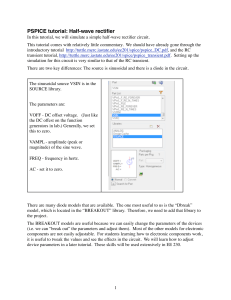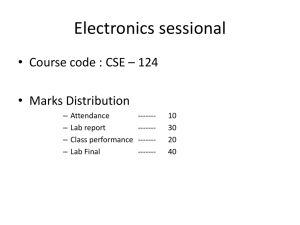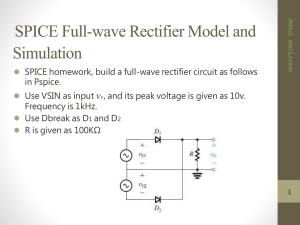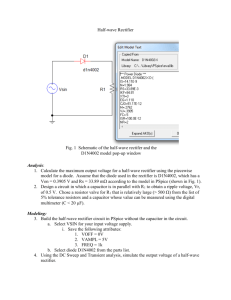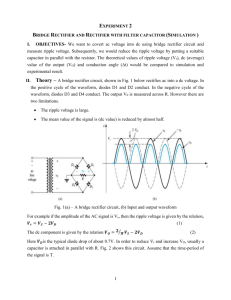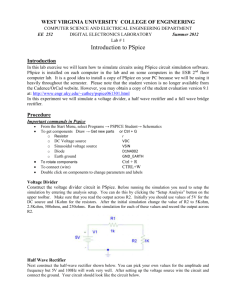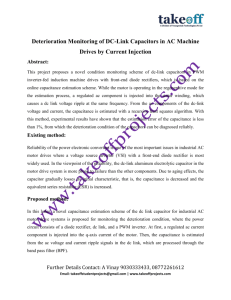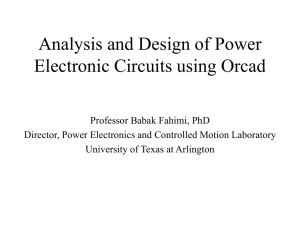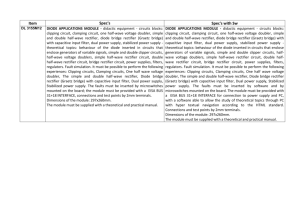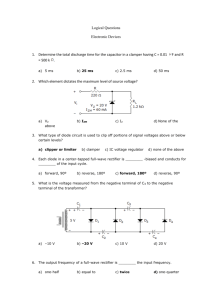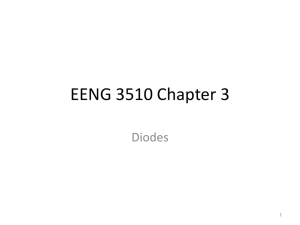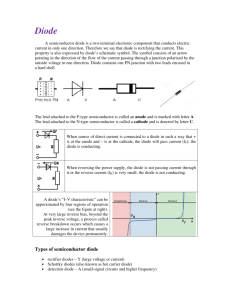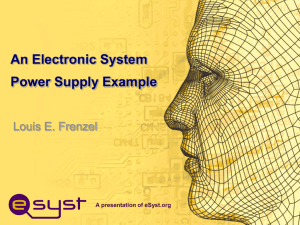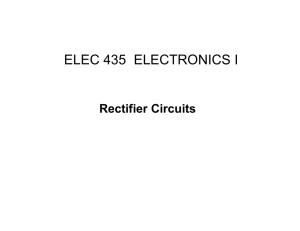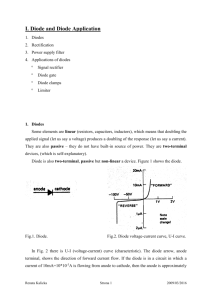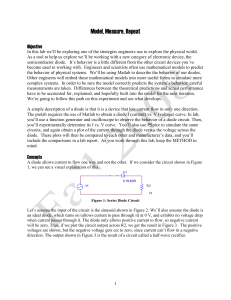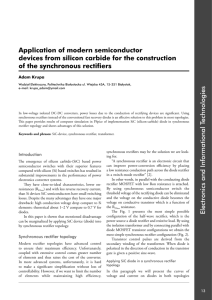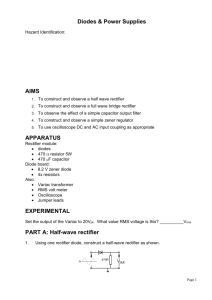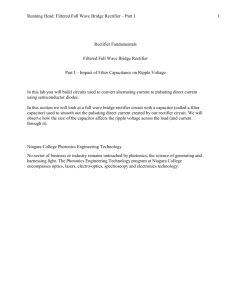Name: Daniel Bernard Team Members: Benjamen Strobel and Jack
advertisement
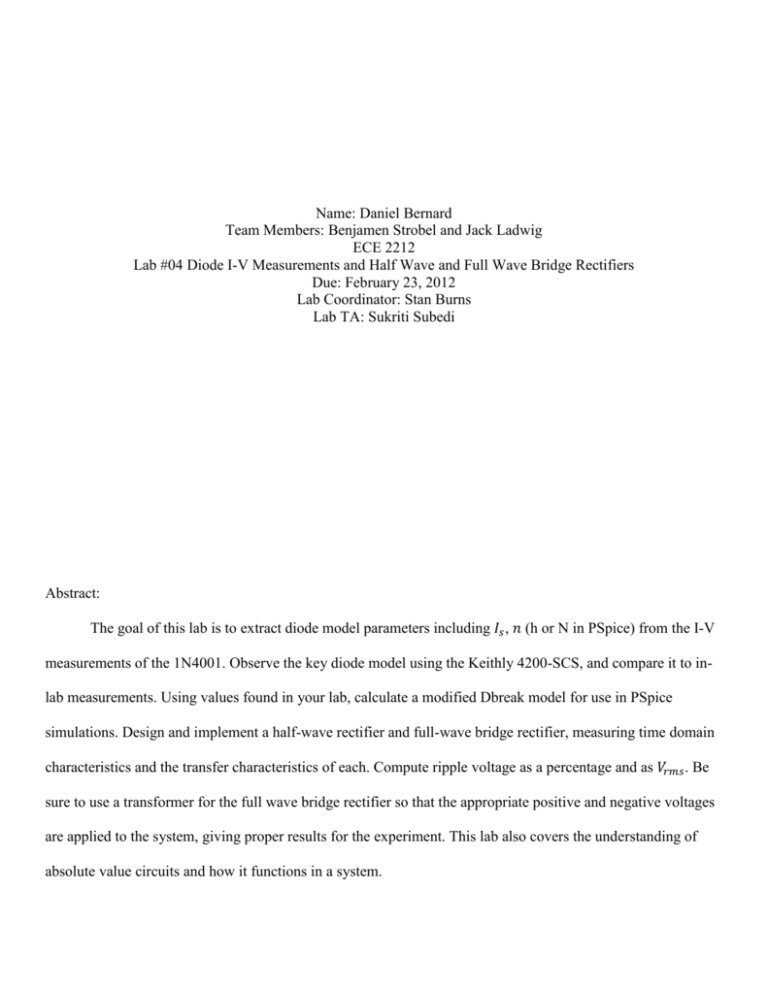
Name: Daniel Bernard Team Members: Benjamen Strobel and Jack Ladwig ECE 2212 Lab #04 Diode I-V Measurements and Half Wave and Full Wave Bridge Rectifiers Due: February 23, 2012 Lab Coordinator: Stan Burns Lab TA: Sukriti Subedi Abstract: The goal of this lab is to extract diode model parameters including 𝐼𝑠 , 𝑛 (h or N in PSpice) from the I-V measurements of the 1N4001. Observe the key diode model using the Keithly 4200-SCS, and compare it to inlab measurements. Using values found in your lab, calculate a modified Dbreak model for use in PSpice simulations. Design and implement a half-wave rectifier and full-wave bridge rectifier, measuring time domain characteristics and the transfer characteristics of each. Compute ripple voltage as a percentage and as 𝑉𝑟𝑚𝑠 . Be sure to use a transformer for the full wave bridge rectifier so that the appropriate positive and negative voltages are applied to the system, giving proper results for the experiment. This lab also covers the understanding of absolute value circuits and how it functions in a system. Introduction: This lab covers the characteristics and diode model parameter extraction using a half-wave rectifier and a diode-bridge full-wave rectifier. The lab includes measurements of voltage and current over specific points in a rectifier, and it’s comparison to a simulated model, including adjustments to the simulated models to match Background: The knowledge given in class about the forward bias current of a diode was necessary for this lab. Also, a brief knowledge of the saturation current and logarithmic relationship between current and voltage in a diode was required for this lab. As always, Knowledge about the operation of the PSpice program was also needed for the completion of this lab. Procedure: I-V Characteristics and Diode Model Parameter Extraction: Simulate in PSpice a program for the circuit shown on the right without the capacitor. Also build the circuit, and attach an ammeter and voltmeter appropriately. Supply 𝑉𝑠 such as to adjust the value for 𝐼𝑑 within a few mA. Compare your data to the information from the Keithly. Half-Wave Rectifier: Using the figure on the right again, remove the capacitor, and input 𝑉𝑠 as 10 𝑉 peak-to-peak 100 𝐻𝑧 sinusoid. Measure and plot 𝑉0 vs 𝑉𝑠 . Illustrate the changes in the waveform using three capacitor values and observe the ripple voltage as a percentage. Diode-Bridge Full-Wave Rectifier: Using the figure on the right input 𝑉𝑠 as 10 𝑉 peak-topeak 100 𝐻𝑧 sinusoid. Measure and plot 𝑉0 vs 𝑉𝑠 . Illustrate the changes in the waveform using three capacitor values and explain how this functions as an absolute value circuit. Be sure to connect the AC source to the circuit through the Transformer, so that the proper phase shifted inverted voltage can be output from the power source. Measurements and Analysis of Results: Part 1 Part 3 0.1𝜇𝐹 Part 3 Oscilloscope 10𝜇𝐹 Part 3 1𝜇𝐹 Part 3 10𝜇𝐹 Half-Wave Rectifier: Dbreak model gives a choppier logarithmic graph than the 1N4002 model. Additionally, 𝑛 = 1.984 for 1N4002 and it isn’t given for Dbreak. The Voltage drop decreases as the capacitance increases. Log of D1N4002 Log of Dbreak model Oscilloscope Values: Vs (V) VD (V) 𝐼𝑑 (mA) 0.2 0.2012 0.00005 0.4 0.4012 0.015 0.6 0.5961 2.46 0.8 0.736 11.65 Log(𝐼𝑑 ) -7.30103 -4.82391 -2.60906 -1.93367 𝑞𝑉 𝑞 log(𝐼𝑑 ) = log(𝐼𝑠 ) + 𝑛𝑘𝑇0 log(𝑒), slope, 𝑚 = 𝑛𝑘𝑇 log(𝑒) = 0.5341 −4.2−(−5.76) 0.6 = 2.6, Let 𝑛 = 6. Diode-Bridge Full-Wave Rectifier: Part 2 Oscilloscope 10𝜇𝐹 Part 2 PSpice 10𝜇𝐹 Part 2 Oscilloscope No Capacitor Part 2 PSpice No Capacitor The circuit works as an absolute value function circuit. This can be shown in both oscilloscope simulations and PSpice simulations when no capacitor is used. It does however have a maximum voltage offset of the voltage rating of the diode, which in this case, is 0.7 𝑉. Summary and Conclusion: The lab has given a better understanding of how a diode can limit current within a circuit. It has shown how an AC source can be converted into a DC circuit by use of a diode. It has also demonstrated that by combining a capacitor with a diode in a circuit, the ripple voltage can be reduced and limited to a certain value. This, in turn, gives the DC effect from the AC source. Also gathered from this lab was the logarithmic relationship between diode current and voltage and how it can be plotted with a simple linear equation.
